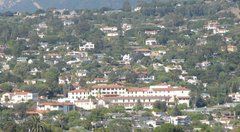
By 1761 the Spanish became concerned over the exploration of the Pacific Coast by Russian trappers and English sailors (both had reached San Francisco). They wanted to establish permanent settlements in California, but lacked the colonists or cash.
The Crown attempted to use the Church to resolve the settlement issue. They began to establish a string of forts and churches that began at San Diego in 1769 and stretched all the way to San Francisco by the 19th century. They were headquartered in Monterrey, but the missions along the Santa Barbara Channel were considered the most important "lynch pin" in the system.
The tribes that lived along the route were loosely affiliated and avoided joining in any organized tasks, such as warfare. Their technology was limited to stone tools, wooden and woven implements, and surprisingly sea-worthy boats. They ate shellfish, birds, small game, acorns, deer, and the occasional beached whale.
The natives numbered perhaps 100,000 in 1776 and by 1830 30,000 had been converted to Spanish mission life. In the first baptism at the Santa Barbara Mission, out of 4,771 natives, only 30 were noted to be unhealthy in anyway. At least three natural remedies from the natives were adopted by Spanish doctors.
The missions were small cities in their own right with a complex of buildings for administration, manufacturing, agriculture, education, and religious functions. The physical layout was governed rules that determined what was built and how it was geographically situated in relation to cardinal directions, hills, and water sources.
Because Spanish settlers were in short supply the missions attempted to convert and educate natives to help settle the land for the Crown. Strict rules against abuse of the non-converted natives attempted to maintain good relations and provide future converts. These caused some friction with lonely soldiers and acquisitive colonists.
Command of the Spanish Empire was centralized and relied upon slow written communication. This caused the settlers to work out elaborate plans for nearly every emergency or contingency. The Crown would later back these rules as The Laws of the Indies.
Natives workers were trained to make adobe bricks, clay roof tiles, build walls, and till fields. Women wove cloth, ground grain, or carded wool. After 10 years of civilizing effort the Crown expected the native communities to carry forward on their own (in California, this effort would last more than 60 years).
Native labor and simple, local, natural materials were all the Spanish had to build with. Dirt, stone, seashell mortar were made into adobe walls. Trees, reeds, and rawhide bindings formed the roofs, floors, and interior walls.
These buildings were solid and offered good shade and natural cooling. Their sheer size, quality craftsmanship, and the best ornament the Crown and the Church could afford, conveyed a sense of permanence and shelter that awed the natives and still impress visitors today.
The secular powers were quite jealous of the economic success of the missions. In 1833 the Mexican government ordered the missions closed or "secularized". Their vast land holdings, stock animals, and native laborers were taken over by neighboring ranchers and farmers.
The supply path that connected these churches became US Hwy 101 and still carries the name El Camino Real or The Royal Road. Today it is marked today by a series of bells hung from shepherd's crooks that dot the highway. While many of the mission buildings are long gone, most of the main chapels still remain and are used today.

No comments:
Post a Comment